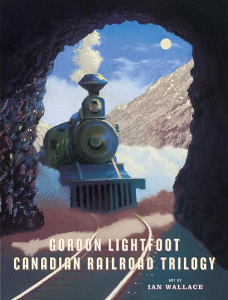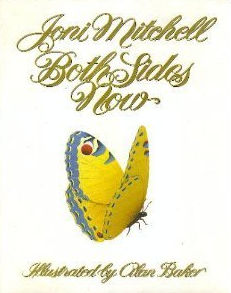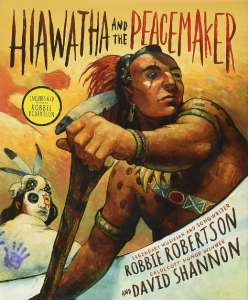“I’m pleased with my life, with the journey.” ~ Tina Turner
Time has passed since my last blog post. I have been navigating some life changes and thinking about journeys, and how life took me in unexpected directions, and put me in situations where I got to do things that I never imagined myself doing. I have been very fortunate in my career as an early childhood educator, viewed my work through different lenses, grown through my experiences and hopefully become a better person for it. These reflections inspired me to put together a collection of picture books about journeys of different kinds – some personal, some historical – stories told in songs by Canadian musicians. Some of the authors are still living, and others no longer, but they are artists who have all lived extraordinary lives, blazed trails and created a legacy of music that makes us think about who we are, about events that have shaped us, and our enormous capacity for resilience and ongoing change.
Hemsworth, Wade and Jennifer Phelan (2018). The Log Driver’s Waltz. Toronto: Simon and Schuster.
 Written in the 1950’s, Hemsworth’s lively and charming song tells a story about the love of a young woman for a log driver who can step lightly both on the river and on the dance floor. Hemsworth must have been inspired by his experiences as a surveyor in Northern Ontario, Quebec and Labrador, living in logging camps and involved in the timber industry. His song provides a glimpse of life in the backwoods, and of log driving, the traditional way of transporting logs down rivers and waterways, from the forest to sawmills. It was difficult, and often dangerous, to burl on logs and stay standing upright on them as they turned over and moved through the water. Jennifer Phelan’s playful illustrations, rendered in watercolour pencil and coloured digitally, show villagers enjoying a social dance. Once the young woman is dancing with her log driver, the floor boards break away from the dance hall, turning into logs where they continue their dance on the river, a nice metaphor for breaking with tradition. She defies the social convention of marrying a successful doctor or lawyer, by marrying the man of her choosing.
Written in the 1950’s, Hemsworth’s lively and charming song tells a story about the love of a young woman for a log driver who can step lightly both on the river and on the dance floor. Hemsworth must have been inspired by his experiences as a surveyor in Northern Ontario, Quebec and Labrador, living in logging camps and involved in the timber industry. His song provides a glimpse of life in the backwoods, and of log driving, the traditional way of transporting logs down rivers and waterways, from the forest to sawmills. It was difficult, and often dangerous, to burl on logs and stay standing upright on them as they turned over and moved through the water. Jennifer Phelan’s playful illustrations, rendered in watercolour pencil and coloured digitally, show villagers enjoying a social dance. Once the young woman is dancing with her log driver, the floor boards break away from the dance hall, turning into logs where they continue their dance on the river, a nice metaphor for breaking with tradition. She defies the social convention of marrying a successful doctor or lawyer, by marrying the man of her choosing.
Lightfoot, Gordon and Ian Wallace (2010). Canadian Railway Trilogy. Toronto: Groundwood Books.
In 1967, Gordon Lightfoot was commissioned to write Canadian Railway Trilogy for Canada’s centennial year. This song captures many things – the natural beauty of Canada, the story of how the Canadian Pacific Railway connected the nation from coast to coast, the cost of human life in this endeavor, and its impact on First Nations peoples. Wallace’s magnificent pastel illustrations conjure up images of a time when the railway did not exist and the land was pristine and undisturbed. With each turn of the page readers can see the transformation of Canada, as more settlers arrived, industry and commerce took hold and railway workers (many from China) laid track, raised wood trestles and dug tunnels through mountains. While the song is about a dream, for those who died or were displaced from their traditional lands, we are reminded that for some, the building of the railroad was a nightmare. Wallace’s illustrations allow us to appreciate and reflect on this song from its different perspectives while the music lets us hear and feel the momentum of a train changing a landscape as it charges through history.
Canada’s centennial year. This song captures many things – the natural beauty of Canada, the story of how the Canadian Pacific Railway connected the nation from coast to coast, the cost of human life in this endeavor, and its impact on First Nations peoples. Wallace’s magnificent pastel illustrations conjure up images of a time when the railway did not exist and the land was pristine and undisturbed. With each turn of the page readers can see the transformation of Canada, as more settlers arrived, industry and commerce took hold and railway workers (many from China) laid track, raised wood trestles and dug tunnels through mountains. While the song is about a dream, for those who died or were displaced from their traditional lands, we are reminded that for some, the building of the railroad was a nightmare. Wallace’s illustrations allow us to appreciate and reflect on this song from its different perspectives while the music lets us hear and feel the momentum of a train changing a landscape as it charges through history.
Mitchell, Joni and Alan Baker (1992). Both Sides Now. New York: Scholastic Inc.
 Both Sides Now is one of my favourite Joni Mitchell songs. I love listening to both the original and later recordings, hearing how time has changed her voice, and her style, feeling that the lyrics have taken on new meanings for me since I first heard the song. I see this as a song about personal reflection, and the realization that nothing stays the same – not your body, not your perception of yourself, nor what you believe, about anything. Things that seem so magical and innocent when you’re young – clouds, love, life – take on a different lustre when your eyes are opened by life experience. Still, what experience teaches you, how it affects you and makes you grow, is worth it, because “something’s lost, but something’s gained, in living every day.” Alan Baker uses a variety of mediums, including watercolour, pen and ink, airbrush and crayon. His beautifully detailed illustrations follow the metamorphosis of a caterpillar into a butterfly, a metaphor for change and personal transformation. Each two-page spread is full of flowers, birds and insects, the sun, moon and stars, clouds, rain and rainbows, all going through natural cycles, while people go through their own changes and make sense of their own life journeys.
Both Sides Now is one of my favourite Joni Mitchell songs. I love listening to both the original and later recordings, hearing how time has changed her voice, and her style, feeling that the lyrics have taken on new meanings for me since I first heard the song. I see this as a song about personal reflection, and the realization that nothing stays the same – not your body, not your perception of yourself, nor what you believe, about anything. Things that seem so magical and innocent when you’re young – clouds, love, life – take on a different lustre when your eyes are opened by life experience. Still, what experience teaches you, how it affects you and makes you grow, is worth it, because “something’s lost, but something’s gained, in living every day.” Alan Baker uses a variety of mediums, including watercolour, pen and ink, airbrush and crayon. His beautifully detailed illustrations follow the metamorphosis of a caterpillar into a butterfly, a metaphor for change and personal transformation. Each two-page spread is full of flowers, birds and insects, the sun, moon and stars, clouds, rain and rainbows, all going through natural cycles, while people go through their own changes and make sense of their own life journeys.
“You wake up one day and suddenly realize that your youth is behind you, even though you’re still young at heart.” ~ Joni Mitchell
Robertson, Robbie and David Shannon (2015). Hiawatha and the Peacemaker. New York: Abrams Books for Young Readers.
In childhood, Robbie Robertson learned about Hiawatha and the Great Peacemaker from an Elder at Six Nations of the Grand River. This experience made a lasting impression on him. In this book, Robertson shares his interpretation of the story of how warring Haudenosaunee tribes would in time agree to collaborate and live according to the Great Law of Peace, governing themselves democratically, through shared power. The book also includes an evocative song composed and recorded by Robertson, inspired by this story, which is an homage to his childhood and his heritage. David Shannon’s vivid and detailed oil paintings help readers to envision the different journeys depicted in this story – from anger to forgiveness, from conflict to peace, from one man’s fierce scream to the beautiful scream of an eagle. The author’s note really speaks to the importance of experiences that resonate in our memories, shape us and become rooted in our own personal stories. After listening to the Elder, Robertson said to his mother, “I hope someday when I grow up, I can tell stories like that.” Through his music, writing and interviews, he has done just that.
an Elder at Six Nations of the Grand River. This experience made a lasting impression on him. In this book, Robertson shares his interpretation of the story of how warring Haudenosaunee tribes would in time agree to collaborate and live according to the Great Law of Peace, governing themselves democratically, through shared power. The book also includes an evocative song composed and recorded by Robertson, inspired by this story, which is an homage to his childhood and his heritage. David Shannon’s vivid and detailed oil paintings help readers to envision the different journeys depicted in this story – from anger to forgiveness, from conflict to peace, from one man’s fierce scream to the beautiful scream of an eagle. The author’s note really speaks to the importance of experiences that resonate in our memories, shape us and become rooted in our own personal stories. After listening to the Elder, Robertson said to his mother, “I hope someday when I grow up, I can tell stories like that.” Through his music, writing and interviews, he has done just that.
“You don’t stumble upon your heritage. It’s there, just waiting to be explored and shared.” ~ Robbie Robertson
Rogers, Stan and Matt James (2012). Northwest Passage. Toronto: Groundwood Books.
 Stan Rogers’ Northwest Passage invites us to imagine what it must have been like for such explorers as Mackenzie, Thompson, Fraser and Franklin to seek a route to the Pacific Ocean by following rivers through the wilderness or sailing through channels in the far north. The song is poignant, a reflection on what has been both gained and lost. The illustrations capture both the majesty and the ferocity of the Canadian landscape. Matt James’ gorgeous paintings, rendered in acrylic and India ink, bring to life the road trip described in Rogers’ song, and interweave this with the stories of early explorers and Indigenous Peoples all part of the fabric of this story. The book includes a map, a timeline of exploration, and an account of the ill-fated travels and tragic demise of John Franklin and his crew. Readers will also find the words and music to Northwest Passage, notes on European explorers and some resources for further learning. Connections can be made between historical events and current issues – the impact of global warming on the Arctic environment, its living creatures and the Inuit who live there, and political disputes over which country should control the use of the Passage for transit, shipping and its mineral wealth. Stan Rogers did not live to see what has become of the historic Northwest Passage that captured his imagination. James writes, “What a loss it is for us that we cannot hear him singing about what is happening in the world today.”
Stan Rogers’ Northwest Passage invites us to imagine what it must have been like for such explorers as Mackenzie, Thompson, Fraser and Franklin to seek a route to the Pacific Ocean by following rivers through the wilderness or sailing through channels in the far north. The song is poignant, a reflection on what has been both gained and lost. The illustrations capture both the majesty and the ferocity of the Canadian landscape. Matt James’ gorgeous paintings, rendered in acrylic and India ink, bring to life the road trip described in Rogers’ song, and interweave this with the stories of early explorers and Indigenous Peoples all part of the fabric of this story. The book includes a map, a timeline of exploration, and an account of the ill-fated travels and tragic demise of John Franklin and his crew. Readers will also find the words and music to Northwest Passage, notes on European explorers and some resources for further learning. Connections can be made between historical events and current issues – the impact of global warming on the Arctic environment, its living creatures and the Inuit who live there, and political disputes over which country should control the use of the Passage for transit, shipping and its mineral wealth. Stan Rogers did not live to see what has become of the historic Northwest Passage that captured his imagination. James writes, “What a loss it is for us that we cannot hear him singing about what is happening in the world today.”
Sainte-Marie, Buffy and Julie Flett (2022). Still This Love Goes On. Vancouver: Greystone Kids.
This book is a stunningly beautiful co-collaboration between Cree singer/songwriter Buffy Sainte-Marie and Cree-Métis author and illustrator Julie Flett. The tender lyrics and delicate artwork set the emotional tone for a very moving reading experience. Every page brings readers into nature’s embrace, filling them with the calm wonder of forests, mountains, fields, valleys, oceans and vast starry skies. The smell of sweetgrass burning, and the sounds of singing, jingle dancing and beating drums fill the senses. You can feel the love of the people and their deep sense of community, as though you feel your own breathing and heart beating. While the song is filled with what feels like the comfort of being where you belong, it also communicates a longing to return home. This all takes on a sad note, in light of the history of residential schools in Canada, and the profound harm caused to Indigenous children, families, language and culture, harm that is still felt by survivors today, something we must always remember. But the refrain that echoes through the song suggests that what is important cannot be taken away, and bonds of love cannot be broken. As sure as the seasons turn and “summer flowers turn the fields to sun”, hope returns, and still the love goes on.
Sainte-Marie and Cree-Métis author and illustrator Julie Flett. The tender lyrics and delicate artwork set the emotional tone for a very moving reading experience. Every page brings readers into nature’s embrace, filling them with the calm wonder of forests, mountains, fields, valleys, oceans and vast starry skies. The smell of sweetgrass burning, and the sounds of singing, jingle dancing and beating drums fill the senses. You can feel the love of the people and their deep sense of community, as though you feel your own breathing and heart beating. While the song is filled with what feels like the comfort of being where you belong, it also communicates a longing to return home. This all takes on a sad note, in light of the history of residential schools in Canada, and the profound harm caused to Indigenous children, families, language and culture, harm that is still felt by survivors today, something we must always remember. But the refrain that echoes through the song suggests that what is important cannot be taken away, and bonds of love cannot be broken. As sure as the seasons turn and “summer flowers turn the fields to sun”, hope returns, and still the love goes on.
“Everybody’s creative. We create our songs and our paintings, our families and our children. Every one of us is on the cutting edge of the future.” ~ Buffy Sainte-Marie
This blog post is dedicated to the memories of Stan Rogers (1949-1983), Gordon Lightfoot (1938-2023) and Robbie Robertson (1943-2023), raconteurs all.
“And many are the dead men, too silent to be real.” ~ Gordon Lightfoot
